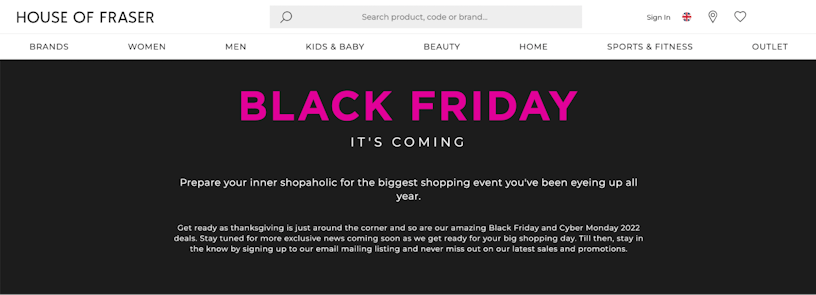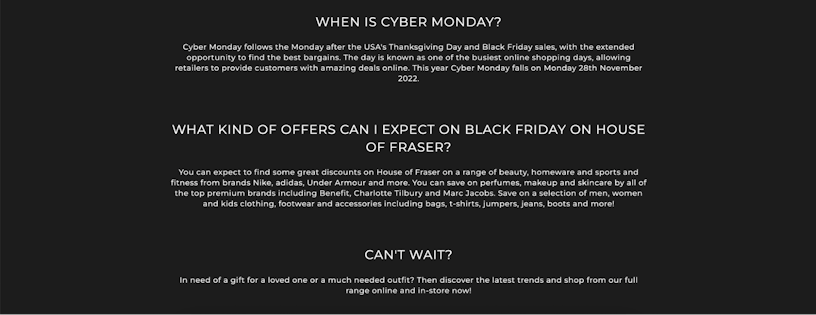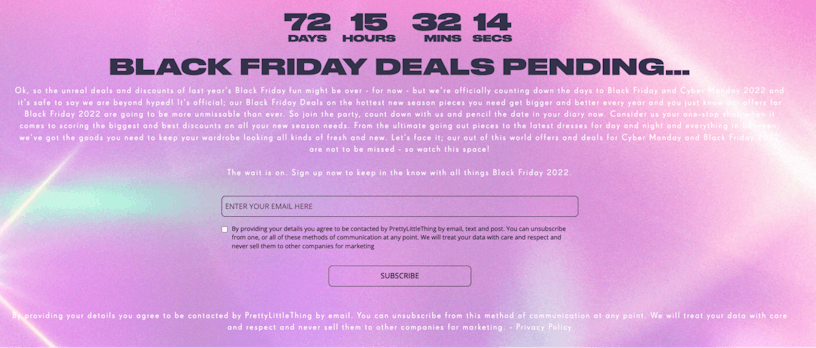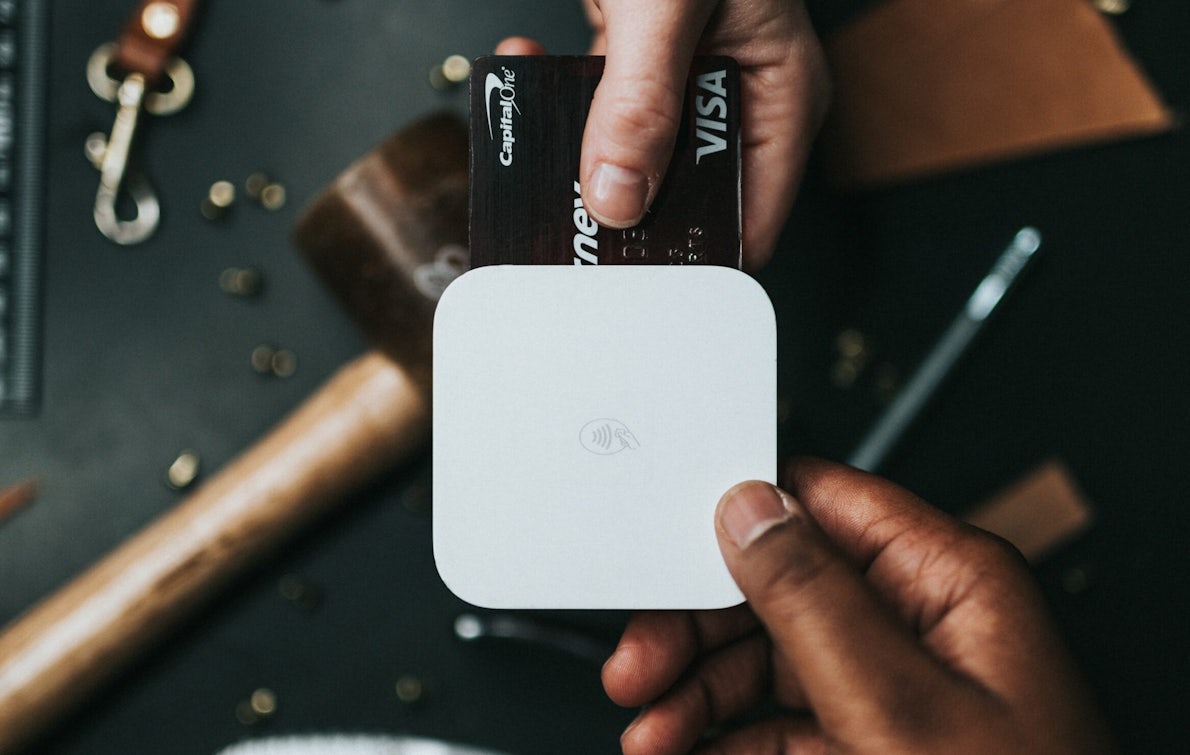Black Friday is on its way. You’ve weighed up the Black Friday vs Cyber Monday debate and started thinking about the great deals and exclusive discounts you’re going to offer your customers over the retail holiday.
Your business may be prepared, but is your on-site content?
As the Black Friday weekend marks the start of the most profitable time of the entire year for many retailers, it really does pay to get it right. Here are some simple on-site content tips to get the most out of your website this festive period.
Create specific landing pages
During the Black Friday period, online shoppers are likely to be quickly browsing through websites looking for the best deals: if they can’t find them almost immediately, they are likely to leave.
By creating specific landing pages for your Black Friday and Cyber Monday campaigns, online shoppers can easily access the specific pages for deals they’re looking for.
Despite inflation and the uncertainty of the current economic climate, the average UK consumer is predicted to increase their spending by 25% in 2022. This is due to consumers wanting to maximise their value for money by seeking the biggest discounts and taking advantage of free returns.
With most high-street retailers reopening and more people visiting stores in-person, ecommerce is still expected to grow, so it’s vital for you to capture your audience by making sure you have landing pages that are well optimised and easy for users to navigate.
Major UK department store House of Fraser, for example, have optimised their Black Friday landing page using a simple ‘black-friday’ slug and clear title for that pulls through to Google Search.

In the same way, online retailer River Island draws attention to their page of online deals with the slug ‘cyber-monday’ and optimised metadata below.

A study found that due to increases in mobile device usage, users often leave web pages in under 15 seconds. That doesn’t give you much time to win over a potential customer.
This means it’s all the more important to create a quick and easy user experience through your on-page content and is good to bear in mind when planning your Black Friday campaigns.
Pay attention to the speed of your landing pages as you create them, and ensure they’re not slowed down by bloated media that doesn’t actively enhance the page experience. Every second you add to the load time will see users bounce right back to the search results.
The upside is clear. A clean, fast user experience leads to engaged customers who are happy browsing the site and finding the best deals, which leads to more sales for you on Black Friday.
Do your keyword research
It goes without saying that the more general ‘Black Friday’/‘Cyber Monday’ sale keywords will have so much competition for them across the ecommerce giants that unless you work for the likes of Amazon, Argos, Currys et al. your time will be better spent elsewhere.
However, a combination of your target keyword and the ‘Black Friday’/‘Cyber Monday’ variable you’re aiming for might be worth experimenting with when you’re optimising your on-site content – people might be searching for your specific products with the desired variable.
The easiest way to generate a list of Black Friday or Cyber Monday quickly is to use the CONCAT function in Excel or Google Sheets, and merge your leading product categories with seasonal terms:

Once you have selected your keyword variables, in this case ‘Black Friday’/‘Cyber Monday’ and an example selection of possible specific keywords users may search for during the Black Friday shopping period, you can merge them together to create long-tail keywords.
These long tail keywords can be entered into keyword software (at Impression we use Ahrefs) to determine their average monthly search volume. Using this information, you can optimise your content accordingly across all elements, including URLs, title tags, meta descriptions and the main body copy.
Remember that keyword tools tend to give monthly averages for search volume even when keywords are highly seasonal. Black Friday keyword volume will be much closer to the monthly search volume x 12 than whatever figure you see, and almost nonexistent for the rest of the year.
Although the search volume may be minimal or, in the cases of both ‘children’s gifts’ variables, non- existent, this is still worth doing. By using longer-tail, more product specific keywords to optimise your content it’s more likely you’ll rank more highly even amongst the competitive Black Friday and Cyber Monday SERPs and even if not, your campaign isn’t going to lose traffic because of it.
Use clear design conventions to guide the user
On-site optimisation is not just down to your written content – good, clear design features are essential too. There are various techniques that can help you get the most from your Black Friday landing pages.
Banners
Banners help clearly signpost specific landing pages you want to draw attention to.
When featured on your homepage, it will let every customer that views it know that you’re offering deals for Black Friday. Cyber Monday bestseller Amazon clearly publicises their participation in Black Friday using a combination of a large hero banner featuring a wide range of discounted products, a ‘countdown’ message in the page header, and an additional banner inviting the user to ‘shop early deals’.
Argos’s use of a banner is as subtle as it is strong: the clarity of design enables easy user access, which is great for reducing bounce rate.

Widgets
A widget is a stand-alone module that can be inserted anywhere around a website, often in the sidebar or on the homepage. They tend to be small and non-intrusive, which makes them ideal for use in Black Friday campaigns.
Widgets can provide users with a shortcut to useful, relevant information, saving the customer the trouble of locating the landing page themselves.
Physically, widgets tend to be small and non-intrusive, which makes them ideal for use in Black Friday campaigns. Widgets linking to Black Friday or Cyber Monday specific
pages could feature on the sidebar of other pages on your website promoting specific product offers or limited edition discounts not advertised in banners on your homepage.
Communicate your event details in advance
Implementing a strong message in the design and message of the landing page on your website can be crucial to drawing people in, and telling them everything they need to know in a matter of seconds.
House of Fraser is one retailer that manages to do this well, clearly detailing the date of the event and letting consumers know exactly what they can expect through a set of Q&A’s.

It does a great job of listing out some Black Friday ‘need to knows’, giving their users the most important information in the lead up to the big day.

PrettyLittleThing has a slightly different approach, with a page that encourages a different way of engaging with their Black Friday activity.

PrettyLittleThing has been very clever in trying to prepare consumers ahead of time. By encouraging keen shoppers to receive regular updates via their newsletters and to get deals directly into their inbox. They’re cleverly trying to gain an advantage for themselves and give engaged users the feeling that they’re getting access to insider information.
Whatever your plans for Black Friday, start building your landing pages as early as possible. The sooner they’re live, the more chance you’ll have of seeing them indexed and ranking in time for the event.
Follow link building opportunities
Buying guides
It’s not just about shouting about your Black Friday deals on your website – if you’ve got genuinely great offers, it’s well worth telling others about them. Link building not only gives you excellent publicity, but it also strengthens your website’s online backlink profile which is great for long-term SEO growth. One great way to do this is to create a buying guide, in which you can shortlist the very best of your Black Friday discounts.
Buying guides, in their easy-to-digest blog format, are also great to use as Black Friday
campaign promotion across your other social media platforms.
Good Housekeeping has published a blog called ‘The best Black Friday beauty deals for 2022’ which shares a beauty directory, directing users to different brands which offer a range of different product lines at different price points, ensuring there will be a Black Friday discount for everyone.
All of these things together create an environment which will guarantee an increased click through rate, meaning more conversions!
Titles such as ‘Top 10…’ or ‘Black Friday Wishlist’ work well for buying guides, as they are both appealing to users and direct in the message. The copy itself in Good Housekeeping’s blog is kept to a minimum: this is important, as your readers only want to know the ‘what’ and ‘when’ of each deal, and they’ll want to know it quickly! Good Housekeeping uses imagery to help readers quickly understand exactly what the product is.
Including buying guides on your website could be a great strategy if you’re an ecommerce store that stocks products from a number of different brands. Alongside each product listing, you could include external links to each brand’s website – some easy promotion for them, and the feature could lead to a link exchange back to your buying guide if they’re happy to reciprocate.
Alternatively, do a little research and select a shortlist of websites and blogs that could be interested in the products on offer in your Black Friday buying guide. Contact them and ask them if they will feature your buying guide, and offer to include an exclusive discount code for their readers in exchange for the feature.
Bloggers in particular are often very happy to do this, but don’t worry if you don’t get much response and focus on building internal links instead. Drive traffic to your site by sharing links to your buying guide across your Facebook and Twitter pages, and feature your blog clearly in any email marketing campaigns you might send out in advance of the
Black Friday shopping holiday. Spread the word as much as possible and it might even lead to a few social shares – the more the merrier.
Digital PR can be a great driver of traffic to your Black Friday campaigns. Try to identify what you’re doing that no one else is and craft that into a newsworthy story.
Directories
If your ecommerce store offers something a little more niche, you could try and get it featured on one of the many Black Friday shopping directories available.
The example below, taken from blackfriday.com, is sectioned clearly into categories so that users can quickly find links to what they’re searching for. This is a great outreach strategy but even better for driving traffic to your website.
Many potential customers will be using search terms such as ‘black friday top 10’ and ‘black friday deals’ and directories such as blackfriday.com have a high SERP rank, making it a great opportunity to spread the word about your offers.

Urgency increases conversions
It’s been tried and tested by ecommerce sites for years, so it’s clear that urgency really works.
Coming into the festive shopping season it’s even more important, as making customers think they’re about to miss out on a great product offer might help your site seal the deal.
Countdown timers are a great way you could implement urgency into your Black Friday campaign this year and help your deals stand out from the crowd.
Adding a countdown timer, either to your website’s homepage or on a product-specific landing page, is one way to create a sense of urgency around your offers. The closer the countdown clock is to zero, the more urgent it becomes, and the more likely your users are to order there and then to avoid missing out on the great deal.
Countdown timers can also be inserted into PPC campaigns. A widget introduced in AdWords allows you to add what Search Engine Land described as a “dynamic countdown”, one that changes automatically when the countdown start and end dates and times are selected.
Once Black Friday is over: what next?
Once the hype is finished, the offers have expired, but your Black Friday landing pages are all still live. Your gut instinct is to delete the pages, or at the very least put them into ‘drafts’.
Rather than removing your Black Friday specific pages completely, you could simply use them to promote any existing sale pages on your website, a great way to keep driving both traffic and sales for your website even after the retail holiday period is over.
For more SEO and digital marketing tips for staying up to date with the latest strategies to maximise your Black Friday sales, visit our blog or check out our latest resources.



